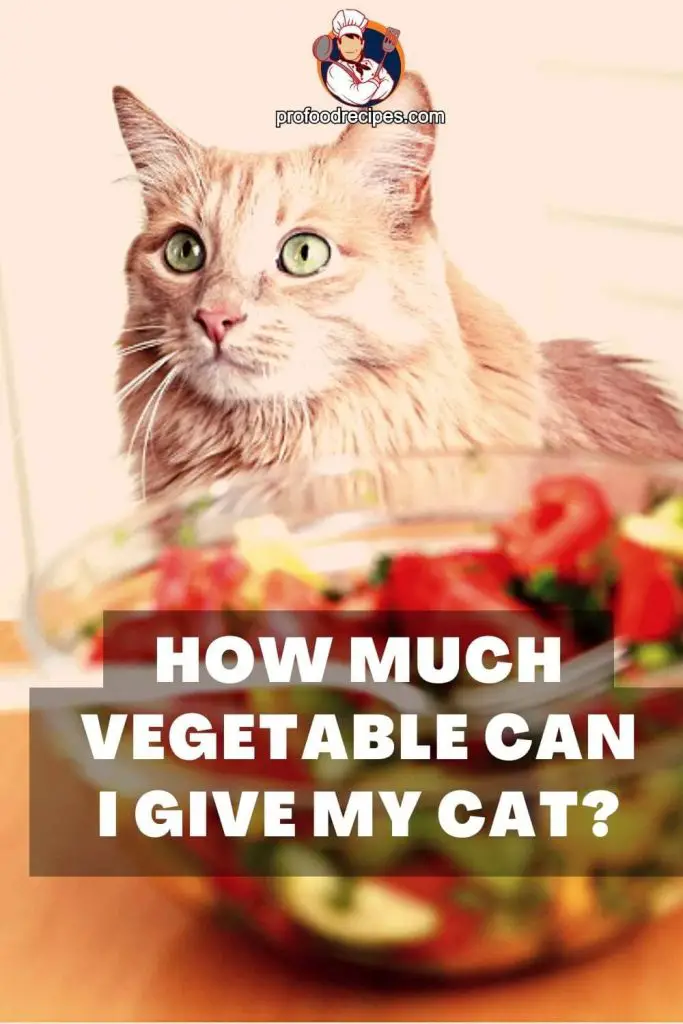Last Updated on June 12, 2022 by Amanda P. Brown
Responsible cat owners are always looking for new ways to keep their feline companions as healthy as possible. Providing a nutritious diet is one of the most vital factors they can do. In addition to their regular diets, cats can eat vegetables as a healthy alternative.
Adding a few properly selected vegetables to their diet could give them more food choices and the necessary vitamins, minerals, and fiber.
If you are considering including vegetables in your cat’s diet, you may be curious about which types of vegetables are healthy for cats to consume. This article explains, What Vegetables Are Best for Cats? And how they may affect our cats?
15 Best Vegetables for Cats
Table of Contents
- Carrots
- Sweet Potatoes
- Broccoli
- Potatoes
- Spinach
- Pumpkin
- Brussels sprouts
- Cauliflower
- Zucchini
- Asparagus
- Green Beans
- Cucumber
- Peas
- Celery
- Lettuce
What Vegetables Are Best for Cats?

Because cats are carnivores, they must consume meat as their primary food source to stay healthy and survive. However, supplementing their diet with minimal amounts of specific vegetables can benefit their overall health. Look at the list below to see what vegetables are best for cats.
1. Carrots
Due to the high levels of minerals and vitamins that carrots contain, they are the ideal vegetable for your cat to consume. Antioxidant beta carotene is abundant in carrots that help your cat’s eyesight and keep the coat shiny. Regarding your cat’s digestive system, carrots are a great source of fiber.
However, are cats able to eat raw carrots? The stringy nature of carrots makes them difficult for cats to eat raw. So give your cat cooked carrots, such as steamed, boiled, or blanched, with no salt or seasoning.
A daily calorie intake of no more than 10% should include in your cat’s “treat portion,” in which you are free to include carrots.
2. Sweet Potatoes
Cooked sweet potatoes are entirely safe for your cat to eat. Sweet potatoes, especially if your cat suffers from constipation, can help them with their poop department because they are high in fiber.
Give your furry sweet potatoes without seasoning or salt by baking, steaming, or boiling.
Raw sweet potatoes are harmful to them and can disrupt their digestive system. Give them only a small amount of sweet potatoes at a time to avoid making them sick with diarrhea and vomiting.
With only 2 percent of their diet coming from fruits and vegetables, one teaspoon of sweet potatoes would be an ideal addition for cats.
3. Broccoli
Broccoli is an excellent vegetable for your cats to eat and is also suitable for their health. Dietary fiber, Vitamin C, and carotenoids are all found in broccoli. Because of these beneficial components, this vegetable will be the healthiest option for their digestive system.
Depending on your cat’s liking, you can steam the florets or feed them raw.
Too much broccoli can upset your cat’s stomach, so be careful not to overfeed them. Cats can feed a small amount of broccoli to supplement their regular diet.
4. Potatoes
Cats can eat potatoes in moderation if they are served without the skin. If the potatoes have been cooked thoroughly, it will be no problem for cats to digest them.
Some cat foods use cooked potatoes as a grain- and gluten-free carbohydrate alternative to the meat in their formulas. Cats should not consume raw potatoes or skinned potatoes. Solanine is a chemical found in raw potatoes that can harm your cat’s digestive and nervous systems.
Potatoes should not give to your cat consistently, but you can treat her occasionally with a bite-sized piece of potato.
5. Spinach
Spinach is an excellent food choice for your feline, with a good fiber source and a wide range of vitamins. For cats, it’s best to cook the Spinach in steamed form as it’s much more digestible.
It’s best not to feed Spinach to a cat with calcium oxalate bladder stones.
However, if your cat is relatively healthy, you should feel free to incorporate Spinach into their diet only a decent amount.
6. Pumpkin
The pumpkin is an excellent dietary fiber, vitamin, and mineral source. It can aid in the recovery process for cats suffering from diarrhea or constipation.
Cooked fresh pumpkin can puree or serve in bite-sized chunks after being fully cooked.
If you are feeding your pet canned pumpkin, avoid brands that have added sugar or spices.
For adult cats, a teaspoon of pumpkin can add to their food, or they can consume it as a treat.
7. Brussels Sprouts
For cats, Brussels sprouts are an excellent source of nutrition because they have a much higher nutrient density.
You can feed your cat Brussels sprouts, but they’ll unlikely enjoy it. The smell and taste of Brussels sprouts bother many cats, so they avoid them. Although cats can eat Brussels sprouts, they are not obligated to do so regularly.
However, if your cat seems interested in it, giving them, a minimal quantity won’t hurt them in any way.
8. Cauliflower
In moderation, cats can eat cauliflower. Cats suffering from arthritis may benefit from the anti-inflammatory properties of cauliflower, which contains antioxidants.
Veterinary experts believe this vegetable may have cancer-fighting properties. Additionally, due to the large levels of fiber that it contains, it promotes healthy digestion as well as the healthy elimination of your cat.
Cats can eat boiled cauliflower. Cauliflower can cause diarrhea if given in excess, so be careful not to overfeed them.
9. Zucchini
Cats can safely eat zucchini. They won’t have any trouble chewing it, and it’s packed with manganese, potassium, and magnesium, all of which are essential nutrients for maintaining strong bones and building muscle.
However, providing them with a few zucchini servings per week can assist them in obtaining the necessary vitamin.
10. Asparagus
Small amounts of Asparagus are entirely safe for your cat. In addition to being suitable for your cat’s digestive system, it also aids in bowel movements. Also, Asparagus is a good choice for pet owners trying to keep their cat’s weight in check.
Excessive consumption of Asparagus can harm your cat’s health due to its high alkaline content. If you give your cat too much of this supplement, she may develop bladder stones.
It’s best to serve your cat asparagus as a treat or as a side dish to a meat-based meal.
11. Green Beans
If it seems like your cats would be interested in eating green beans, then you should consider giving them green beans that have been steamed or cooked. Green beans contain a good amount of iron and protein, both beneficial to your cat’s digestive system.
The ideal serving size for your cat is four or five green beans at a time.
12. Cucumber
Small amounts of cucumber are safe for cats to eat. Nearly all of the water in cucumber is absorbed by the plant. Cats are naturally thirsty, so this is an excellent way to keep them well-hydrated.
Aside from that, it is packed with essential nutrients for your cat’s wellbeing, such as magnesium and potassium. The vitamin K found in cucumbers is known to support healthy liver function as well as normal blood clotting.
Provide your cat with one or two cucumber slices weekly.
13. Peas
Peas are also safe and non-toxic vegetables for cats to eat. This vegetable is rich in potassium, fiber, vitamins, and protein, among other nutrients. Peas are a good source of protein and fiber for your cat, and you can give them as a snack or as part of their main meal.
Cooked and raw peas are both acceptable methods of preparation for your cat. You can feed cooked peas to your cat if they are steamed plain. Steaming the peas in their natural state before feeding them to your cat is recommended.
Overconsumption of peas, on the other hand, can cause nausea, vomiting, and other symptoms of the gastrointestinal tract.
You should feel free to feed your cat more than one cooked pea at a time as part of his diet.
14. Celery
There are a lot of cats that enjoy eating celery, and they also enjoy munching on it. Your cat can consume a small amount of celery without ill effects, but only if the amount is kept in moderation.
Your cat will benefit from the fiber content in celery and the numerous vitamins and minerals it contains. Celery in its raw form is safe for cats to consume.
Providing your cat with too much celery at once can cause digestive upset and even diarrhea, so be careful not to overdo it.
Cats can safely eat one tablespoon of celery per day as a 10% portion of their diet.
15. Lettuce
Lettuce has high water content, making it a good option for cats with trouble staying hydrated. There are numerous advantages to feeding lettuce to your cat, one of which is that the low caloric content of lettuce alleviates any concerns you may have about your cat putting on weight.
Feeding your cat a piece of lettuce is the most effective way to meet various dietary needs.
How Much Vegetable Can I Give My Cat?

If you want to offer your cat some vegetables, you should bake or steam them first, then cut them up into small pieces. Serve the vegetables either plain or pureed, and add them to your cat’s regular kibble as a healthy alternative.
Cat treats, such as vegetables, should make up no more than 10% of your cat’s daily recommended caloric intake, with high-quality cat food accounting for the vast majority of that.
Can Cats Digest Vegetable Protein?
Cats and dogs can effectively digest the plant protein in their respective diets. The digestibility of plant protein in dogs remained the same even as the amount of plant protein increased. It has been observed that feeding cats dry food increases their ability to digest plant protein.
What Human Food Can Cats Eat?
A list of human foods that cats can eat safely follows.
- Melon
- Salmon
- Cheese
- Rice
- Berries
- Fish oils
- Cantaloupe
- Bananas
- Chicken
- Bread
- Pumpkin
- Beef
- Blueberries
- Turkey
- Apples
Final Verdict
To meet their nutritional requirements, cats must eat meat, the only protein source they can obtain. Meat-based diets are the best for your cat’s wellbeing.
On the other hand, cat owners are often unaware of what their pets can eat in addition to their usual cat food. Vegetables are relatively safe for cats, but they should only be given as a special treat and not be the mainstay of their diet.
But What Vegetables Are Best for Cats? The above list, which includes some of the best vegetables for cats, may be of assistance to you in providing better care for your feline friend.
Seek advice from your veterinarian before offering your cat new food.
You May also Like to Read:
- 7-Best Vet Approved Homemade Cat Food Recipes
- Best Homemade Food for Persian Kitten
- Wet Cat Food – 26 Question and Answer
- Dry Vs Wet Cat Food Cat Food Pros and Cons- Well Explained
- Best Homemade Food for Persian Cats
